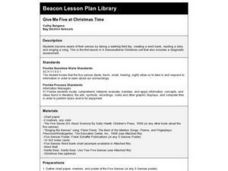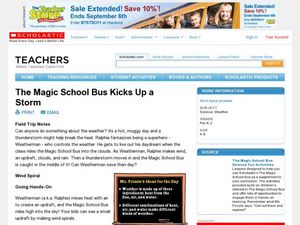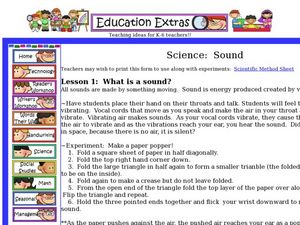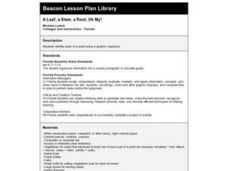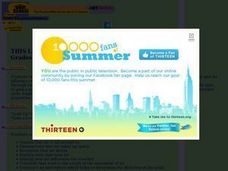Curated OER
Pumpkin Investigations
This series of investigations lead students to have a greater understanding of the pumpkin and give them a chance to experience scientific study.
Curated OER
Magnify It!
Students explain that there are limits to what the eye can see and that a magnifying glass can help extend those limits. They examine an object with the magnifying glass and draw the size and shape of what they see as accurately as they...
Curated OER
Give Me Five at Christmas Time
Students study about senses by taking a walking field trip, creating a word bank, reading a story and singing a song.
Curated OER
The Magic School Bus Kicks Up a Storm
Young scholars investigate how warm air from a lamp affects a spiral of paper. They determine how the warm air rises while cooler air moves into take its place which creates wind in this Magic School Bus activity.
Curated OER
Air and Water in the Environment
Second graders participate in a three part lesson plan in which they identify and describe forms of moisture in the environment. Part one of the lesson plan involves the three stages of the water cycle, part two focuses on creating...
Curated OER
The Respiratory System
The student will calculate the vital capacity of the air in the lungs and trace the pathway of air into and out of the lungs. They describe the pressure changes that occur within the chest cavity when you breathe. They compare air that...
Curated OER
Drawing From Nature
Students observe similarities and differences of natural objects. In this observation instructional activity, students use a magnifying glass to identify the details of objects.
Curated OER
Plants from Trash
Students observe how plants recycle themselves, and discuss different types of propagation.
Curated OER
How is Lightning Formed
Young scholars research lightning paying particular attention to how it is formed, where it is most likely to occur, and how most people struck by lightning survive.
Curated OER
Worm Composting: Vermiculture
Students set up their own composting bin. They observe and record their findings during a period of time. They describe the decomposing process as well.
Curated OER
Earth to Saturn, Earth to Saturn!
Learners compare and contrast the characteristics of Earth and Saturn. They practice writing analogies using those characteristics. They complete a worksheet to end the instructional activity.
Curated OER
Lightning
Young scholars investigate lightning. In this lightning lesson, students demonstrate how static electricity is in the air by observing how a balloon reacts to a charge.
Curated OER
Moving Objects
Second graders investigate pushing and pulling. In this lesson plan on how objects move, 2nd graders experiment with marbles to see how one marble can be moved by getting hit by another marble.
Curated OER
Color Splash
Students investigate density. In this density lesson plan, students conduct an experiment using food coloring. Students observe the differences in mixing food coloring in water and oil.
Curated OER
What is a Sound?
Second graders explore the concept of sound. In this sound lesson, 2nd graders discover what sound, vibrations, and pitch are through several experiments. Students watch a Power Point presentation that allows them to complete a graphic...
Curated OER
Where in the World?
Students evaluate botany by participating in a class discussion. In this agriculture lesson, students identify the importance of knowing where food comes from and they discuss what their breakfast consisted of and where it came from....
Curated OER
Build Your Own Parachute
Students study the basics of parachuting. For this flight and aerodynamics lesson students make a simple parachute and investigate different variables that can cause potential problems.
Curated OER
PLATE TECTONICS WITH AN ORANGE
Students explore the concept of plate tectonics. They experiment to prove and explain plate tectonics.
Curated OER
A Leaf, a Stem, a Root, Oh My!
Students conduct Internet research on plants and complete a WebQuest on vegetable plants. They use a graphic organizer to display their findings, observe actual vegetables and design a salad, noting which part of each plant is included.
Curated OER
See How They Grow: Plants And Their Parts
Students discuss what plants require in order to grow, identify plant parts and their functions and discuss a video about plants. They conduct a controlled experiment with bean seeds and then record and observe the bean plants.
Curated OER
This Lesson Is a Breeze, So Don't Blow It!
Students conduct an experiment to show that air is all around us and that wind is the movement of air. They construct a weather vane to determine which direction the wind is blowing.
Curated OER
Contaminated Drinking Water
Students see if they can tell if our water is safe to drink by looking at it and tasting it. They perform an experiment using salt and vinegar to see when they can tell water has been contaminated.
Curated OER
Create a Soil Aggregate
Students simulate the conditions which occur in a soil aggregate. They explain how IPM affects the environment. They identify the cast of characteristics to develop their aggregate.
Curated OER
Comets And Meteor Showers
Young scholars fill in a diagram of a comet. They listen to a short lecture, view flash animation descriptions of comets and meteors and then use the presented information to complete a worksheet.
Other popular searches
- Space Science
- Astronomy and Space Science
- Physical Science Space
- Earth and Space Science
- Science Space Experiment
- Space Science Vocabulary
- Science Space Lessons
- Space Science Astronomy
- Science Space Race
- Star Maps Science Space
- Earth Space Science
- Science Space Station




